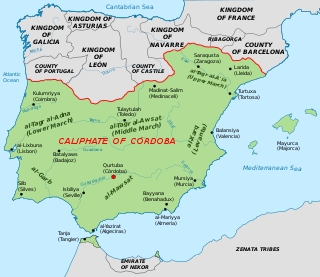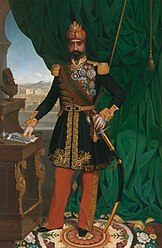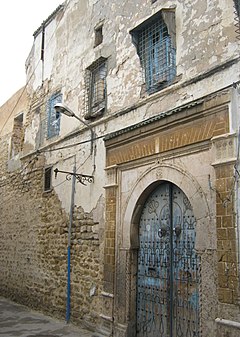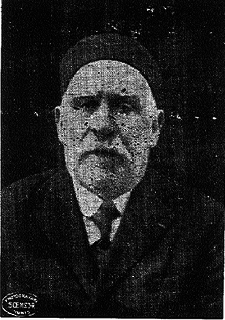
Dar Balma is an old palace in the medina of Tunis.

Dar Balma is an old palace in the medina of Tunis.

The palace is located in the Sidi Bou Khrissan Street.
An old Andalusian family built the palace at the end of the 16th century or at the beginning of the 17th century. [1]

Al-Andalus, also known as Muslim Spain, Muslim Iberia, or Islamic Iberia, was a medieval Muslim territory and cultural domain that in its early period included most of Iberia, today's Portugal and Spain. At its greatest geographical extent, it occupied the northwest of the Iberian peninsula and a part of present-day southern France, Septimania, and for nearly a century extended its control from Fraxinet over the Alpine passes which connect Italy with the remainder of Western Europe. The name more generally describes the parts of the peninsula governed by Muslims at various times between 711 and 1492, though the boundaries changed constantly as the Christian Reconquista progressed, eventually shrinking to the south around modern-day Andalusia and then to the Emirate of Granada.

The 16th century begins with the Julian year 1501 and ends with either the Julian or the Gregorian year 1600.

The 17th century was the century that lasted from January 1, 1601, to December 31, 1700. It falls into the Early Modern period of Europe and in that continent was characterized by the Baroque cultural movement, the latter part of the Spanish Golden Age, the Dutch Golden Age, the French Grand Siècle dominated by Louis XIV, the Scientific Revolution, the world's first public company Dutch East India, and according to some historians, the General Crisis. The greatest military conflicts were the Thirty Years' War, the Great Turkish War, Mughal–Safavid Wars (Mughal–Safavid War, Mughal–Safavid War ), Mughal-Maratha Wars, and the Dutch-Portuguese War. It was during this period also that European colonization of the Americas began in earnest, including the exploitation of the silver deposits, which resulted in bouts of inflation as wealth was drawn into Europe.
The first plank of Victor Valensi's book L'Habitation tunisienne represents the door of Dar Balma. [2]

Tunis is the capital and the largest city of Tunisia. The greater metropolitan area of Tunis, often referred to as Grand Tunis, has some 2,700,000 inhabitants.

Muhammad III as-Sadiq GCB was the Husainid Bey of Tunis from 1859 until his death. Invested as Bey al-Mahalla on 10 June 1855, he succeeded his brother Muhammad II ibn al-Husayn on 23 September 1859. Named as divisional General in the Imperial Ottoman Army on 10 June 1855, he was promoted to the rank of Marshal on 10 December 1859.

Mohammed Bey or M'hamed Bey , was the eleventh Husainid Bey of Tunis, ruling from 1855 until his death. He was the son of Al-Husayn II ibn Mahmud and his second wife Lalla Fatima al-Munastiri.

The Medina of Tunis is the Medina quarter of Tunis, capital of Tunisia. It has been a UNESCO World Heritage Site since 1979.
Hammuda Pasha Bey, died 1666 was the second Bey of the Tunisian Muradid dynasty. He reigned from 1631 until his death.
Uthman Dey or Kara Osman Dey was Dey of Tunis from 1593 until his death.

Radio Tunis called Tunisian National Radio or Radio of Tunisia, founded in October 1938, is the primary radio station of Tunisia whose offices are located at Tunis.
Dar Djellouli is an old palace of the medina of Tunis. It is located in the Street of the Rich in Bab Jedid, near Tourbet el Bey.

Dar Al Jaziri is a palace in the medina of Tunis. Located in the Tribunal Street, a few meters from Dar Lasram, it was one of the residences of the Jaziri family between the 12th and 18th centuries.

Dar Ibn Abi Dhiaf is a palace in the medina of Tunis, located near the Pasha Street and Sidi Mahrez Mosque, in the Ibn Abi Diaf dead end.

Dar Bach Hamba is an old palace in the medina of Tunis.

Dar El Haddad is one of the oldest palaces in the medina of Tunis.

Dar Othman is one of the palaces of the medina of Tunis. The residence is located in the south of the medina, 16 El Mebazaâ Street.

Dar Bou Hachem is a palace in the medina of Tunis.

Dar Hammuda Pasha is an old palace in the medina of Tunis. It is considered as one of the oldest and biggest palaces of the medina that kept their original architecture.
Dar Zarrouk is one of the palaces of the old town of Tunis. It is one of the largest historical palaces in Tunis.

Dar Djaït is an old palace of the Medina of Tunis. It is located in the Street of Sidi ben Arous.

Dar El Cherif is an old palace in the Medina of Tunis.

Abdeljelil Zaouche, was a politician, reformer and campaigner in the Tunisian independence movement.

Jacob Chemla was a Tunisian Jewish ceramic artist, as well as an author, journalist and translator in Judeo-Tunisian Arabic.
| Wikimedia Commons has media related to Dar Balma . |